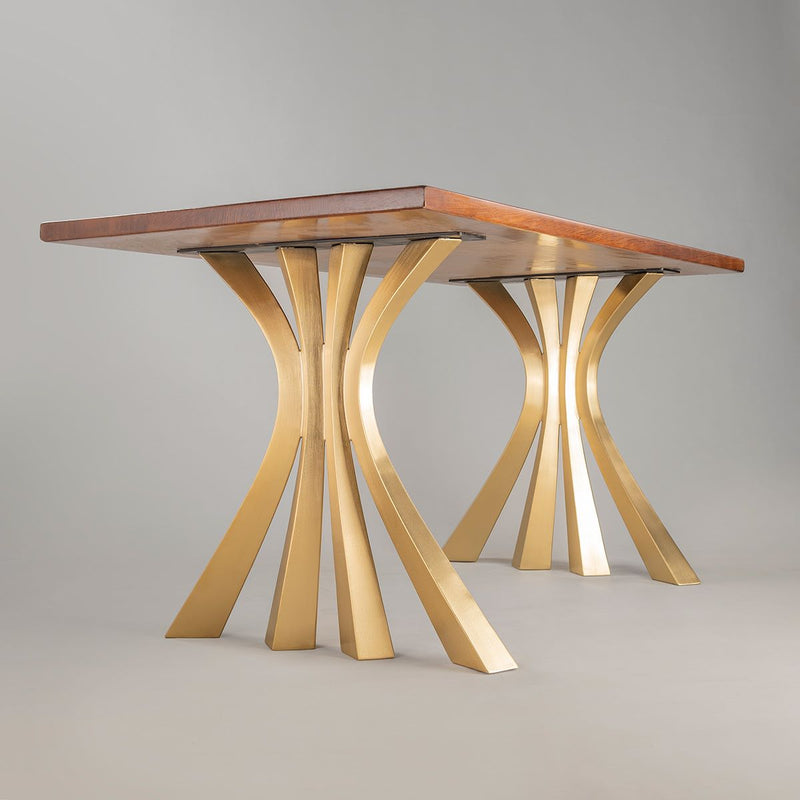Dining Room Table Legs That Integrate Capability and Modern Design
Dining Room Table Legs That Integrate Capability and Modern Design
Blog Article
A Detailed Consider Dining Table Leg Styles: Locating the Suitable Match
Picking the right dining table leg design is vital for both visual charm and useful performance. For those with larger tables, trestle legs make sure strong support, whereas hairpin legs introduce a mid-century contemporary vibe with their minimal layout. The x-shaped legs mix modern style with enhanced security.
Typical Four Legs
Among the different types of dining table leg styles, the traditional four-leg design remains a classic selection for numerous homes. Four legs give balanced assistance, ensuring the table stays secure and qualified of bearing considerable weight (dining room table legs).
From an aesthetic point of view, the standard four-leg style can be quickly adjusted to different interior designs. Whether crafted from wood, steel, or a mix of products, these legs can be delicately sculpted, smooth and minimalistic, or anything in between. Their adaptability allows them to complement both rustic and modern setups flawlessly.
Moreover, the uncomplicated framework of the four-leg style facilitates convenience of activity and placement within an area. Unlike even more complicated bases, this design decreases blockages, giving adequate legroom for restaurants. In summary, the conventional four-leg dining table leg style weds withstanding style with practical functionality, making it an astute option for those looking for both form and function in their dining furnishings.
Pedestal Base
Commonly celebrated for its sophisticated and space-efficient design, the stand base is a recognized option to the typical four-leg setup in eating table leg styles. Without corner legs, diners are managed higher liberty of movement, making it a perfect option for round and oval tables that advertise even more intimate and comprehensive gatherings.
Additionally, the stand base's central support can deal with substantial weight, enabling for the use of heavier tabletops, such as marble or thick wood. This toughness combined with its aesthetic adaptability makes the pedestal base a popular option in both typical and contemporary interior settings. It can seamlessly integrate with various style motifs, from traditional elegance to minimalist modernity. Moreover, the main column itself offers a canvas for elaborate styles and creative expressions, adding an aspect of aesthetic rate of interest under the table. In summary, the pedestal base combines capability snappy, making it a fine-tuned and practical option for varied dining settings.
Trestle Legs
Trestle legs supply a robust and ageless structure for eating tables, characterized by their horizontal cross-bracing and strong assistance beams. Stemming from medieval times, this layout has actually progressed yet preserved its vital framework, making it a seasonal fave in both conventional and contemporary settings. The central trestle beam, commonly supported by two or more vertical posts, provides outstanding security, enabling for larger table lengths without the demand for additional legs.
A substantial advantage of trestle leg tables is the adequate legroom they provide. Unlike tables with 4 edge legs, the lack of blockages at the table's sides provides unblocked space for chairs and restaurants, enhancing comfort and accessibility. This makes trestle tables perfect for fitting larger gatherings, whether in an eating area or a reception hall.
From rustic farmhouse to sleek contemporary layouts, trestle legs can be tailored to match specific preferences. Their enduring appeal and functional benefits make trestle legs an engaging selection for those seeking both design and usefulness in their dining table.
Barrette Legs

The appeal of hairpin legs lies in their simpleness and flexibility - dining room table legs. Available in a variety of materials, including steel and brass, they can be ended up in various shades to complement various interior designs. Whether paired with a rustic wooden her comment is here tabletop or a modern glass surface, barrette legs effortlessly blend capability with a touch of classic appeal
Resilience is an additional significant feature of barrette legs. In spite of their fragile appearance, these legs are engineered to bear substantial weight, making sure the table remains secure and safe and secure. Furthermore, they are relatively simple to set up, making them a preferred selection for DIY lovers and expert furnishings manufacturers useful content alike.
X-Shaped Legs

Built from materials such as steel, wood, or a mix of both, X-shaped legs can be tailored to match different style preferences. Steel legs often offer a smooth and commercial feel, perfect for loft-style homes and modern-day dining rooms. On the other hand, wooden X-shaped legs offer a warmer, much more rustic allure, suitable for farmhouse or eclectic interiors. The adaptability in products permits property owners to personalize their table to better fit their total design scheme.
Moreover, the design behind X-shaped legs makes advice sure also weight distribution, minimizing the risk of wobbling and enhancing longevity. This makes them specifically fit for bigger table that require extra assistance. Basically, X-shaped legs mix functional engineering with modern-day aesthetic appeals, making them an ageless option for varied eating settings.
Verdict
A detailed understanding of dining table leg designs discloses the unique attributes and benefits of each style. Traditional 4 legs offer security and timeless allure, while pedestal bases supply legroom and a streamlined appearance. Trestle legs make sure robust assistance for larger tables, and hairpin legs introduce a mid-century modern-day aesthetic. X-shaped legs combine modern layout with enhanced security. Choosing the ideal leg design makes certain both practical and aesthetic fulfillment in any kind of dining room.
Report this page